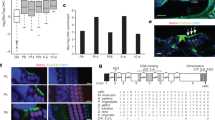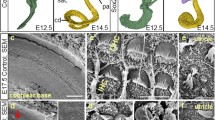Abstract
Ear development requires the transcription factors ATOH1 for hair cell differentiation and NEUROD1 for sensory neuron development. In addition, NEUROD1 negatively regulates Atoh1 gene expression. As we previously showed that deletion of the Neurod1 gene in the cochlea results in axon guidance defects and excessive peripheral innervation of the sensory epithelium, we hypothesized that some of the innervation defects may be a result of abnormalities in NEUROD1 and ATOH1 interactions. To characterize the interdependency of ATOH1 and NEUROD1 in inner ear development, we generated a new Atoh1/Neurod1 double null conditional deletion mutant. Through careful comparison of the effects of single Atoh1 or Neurod1 gene deletion with combined double Atoh1 and Neurod1 deletion, we demonstrate that NEUROD1-ATOH1 interactions are not important for the Neurod1 null innervation phenotype. We report that neurons lacking Neurod1 can innervate the flat epithelium without any sensory hair cells or supporting cells left after Atoh1 deletion, indicating that neurons with Neurod1 deletion do not require the presence of hair cells for axon growth. Moreover, transcriptome analysis identified genes encoding axon guidance and neurite growth molecules that are dysregulated in the Neurod1 deletion mutant. Taken together, we demonstrate that much of the projections of NEUROD1-deprived inner ear sensory neurons are regulated cell-autonomously.










Similar content being viewed by others
References
Driver EC, Kelley MW (2020) Development of the cochlea. Development 147(12):dev162263. https://doi.org/10.1242/dev.162263
Zou D, Silvius D, Fritzsch B, Xu P-X (2004) Eya1 and Six1 are essential for early steps of sensory neurogenesis in mammalian cranial placodes. Development 131(22):5561–5572
Kiernan AE, Pelling AL, Leung KK, Tang AS, Bell DM, Tease C, Lovell-Badge R, Steel KP et al (2005) Sox2 is required for sensory organ development in the mammalian inner ear. Nature 434(7036):1031–1035
Karis A, Pata I, van Doorninck JH, Grosveld F, de Zeeuw CI, de Caprona D, Fritzsch B (2001) Transcription factor GATA-3 alters pathway selection of olivocochlear neurons and affects morphogenesis of the ear. J Comp Neurol 429(4):615–630
Bouchard M, de Caprona D, Busslinger M, Xu P, Fritzsch B (2010) Pax2 and Pax8 cooperate in mouse inner ear morphogenesis and innervation. BMC Dev Biol 10(1):89
Raft S, Groves AK (2014) Segregating neural and mechanosensory fates in the developing ear: patterning, signaling, and transcriptional control. Cell Tissue Res 359:315–332. https://doi.org/10.1007/s00441-014-1917-6
Fritzsch B, Elliott KL (2017) Gene, cell, and organ multiplication drives inner ear evolution. Dev Biol 431(1):3–15. https://doi.org/10.1016/j.ydbio.2017.08.034
Ma Q, Anderson DJ, Fritzsch B (2000) Neurogenin 1 null mutant ears develop fewer, morphologically normal hair cells in smaller sensory epithelia devoid of innervation. J Assoc Res Otolaryngol 1(2):129–143
Kim W-Y, Fritzsch B, Serls A, Bakel LA, Huang EJ, Reichardt LF, Barth DS, Lee JE (2001) NeuroD-null mice are deaf due to a severe loss of the inner ear sensory neurons during development. Development 128(3):417–426
Jahan I, Pan N, Kersigo J, Fritzsch B (2010) Neurod1 suppresses hair cell differentiation in ear ganglia and regulates hair cell subtype development in the cochlea. PLoS One 5(7):e11661. https://doi.org/10.1371/journal.pone.0011661
Kopecky BJ, Jahan I, Fritzsch B (2013) Correct timing of proliferation and differentiation is necessary for normal inner ear development and auditory hair cell viability. Dev Dyn 242(2):132–147
Pan N, Jahan I, Kersigo J, Duncan JS, Kopecky B, Fritzsch B (2012) A novel Atoh1 “self-terminating” mouse model reveals the necessity of proper Atoh1 level and duration for hair cell differentiation and viability. PLoS One 7(1):e30358. https://doi.org/10.1371/journal.pone.0030358
Pan N, Jahan I, Kersigo J, Kopecky B, Santi P, Johnson S, Schmitz H, Fritzsch B (2011) Conditional deletion of Atoh1 using Pax2-Cre results in viable mice without differentiated cochlear hair cells that have lost most of the organ of Corti. Hear Res 275(1-2):66–80. https://doi.org/10.1016/j.heares.2010.12.002
Bermingham N, Hassan B, Price S, Vollrath M, Ben-Arie N, Eatock R, Bellen H, Lysakowski A et al (1999) Math1: an essential gene for the generation of inner ear hair cells. Science 284:1837–1841
Macova I, Pysanenko K, Chumak T, Dvorakova M, Bohuslavova R, Syka J, Fritzsch B, Pavlinkova G (2019) Neurod1 Is essential for the primary tonotopic organization and related auditory information processing in the midbrain. J Neurosci 39(6):984–1004. https://doi.org/10.1523/JNEUROSCI.2557-18.2018
Yang L, Cai CL, Lin L, Qyang Y, Chung C, Monteiro RM, Mummery CL, Fishman GI et al (2006) Isl1Cre reveals a common Bmp pathway in heart and limb development. Development 133(8):1575–1585. https://doi.org/10.1242/dev.02322
Goebbels S, Bode U, Pieper A, Funfschilling U, Schwab MH, Nave KA (2005) Cre/loxP-mediated inactivation of the bHLH transcription factor gene NeuroD/BETA2. Genesis 42(4):247–252. https://doi.org/10.1002/gene.20138
Shroyer NF, Helmrath MA, Wang VY, Antalffy B, Henning SJ, Zoghbi HY (2007) Intestine-specific ablation of mouse atonal homolog 1 (Math1) reveals a role in cellular homeostasis. Gastroenterology 132(7):2478–2488. https://doi.org/10.1053/j.gastro.2007.03.047
Dvorakova M, Jahan I, Macova I, Chumak T, Bohuslavova R, Syka J, Fritzsch B, Pavlinkova G (2016) Incomplete and delayed Sox2 deletion defines residual ear neurosensory development and maintenance. Sci Rep 6:38253. https://doi.org/10.1038/srep38253
Bohuslavova R, Dodd N, Macova I, Chumak T, Horak M, Syka J, Fritzsch B, Pavlinkova G (2017) Pax2-Islet1 transgenic mice are hyperactive and have altered cerebellar foliation. Mol Neurobiol 54(2):1352–1368. https://doi.org/10.1007/s12035-016-9716-6
Fritzsch B, Duncan JS, Kersigo J, Gray B, Elliott KL (2016) Neuroanatomical tracing techniques in the ear: history, state of the art, and future developments. In: Sokolowski B (ed) Auditory and vestibular research: methods and protocols, vol 1427. Springer Science+Business Media, New York, pp. 243–262
Simmons D, Duncan J, de Caprona DC, Fritzsch B (2011) Development of the inner ear efferent system. In: Auditory and vestibular efferents. Springer, Berlin, pp. 187–216
Bolger AM, Lohse M, Usadel B (2014) Trimmomatic: a flexible trimmer for Illumina sequence data. Bioinformatics 30(15):2114–2120. https://doi.org/10.1093/bioinformatics/btu170
Kopylova E, Noe L, Touzet H (2012) SortMeRNA: fast and accurate filtering of ribosomal RNAs in metatranscriptomic data. Bioinformatics 28(24):3211–3217. https://doi.org/10.1093/bioinformatics/bts611
Dobin A, Davis CA, Schlesinger F, Drenkow J, Zaleski C, Jha S, Batut P, Chaisson M et al (2013) STAR: ultrafast universal RNA-seq aligner. Bioinformatics 29(1):15–21. https://doi.org/10.1093/bioinformatics/bts635
Anders S, Pyl PT, Huber W (2015) HTSeq--a Python framework to work with high-throughput sequencing data. Bioinformatics 31(2):166–169. https://doi.org/10.1093/bioinformatics/btu638
Love MI, Huber W, Anders S (2014) Moderated estimation of fold change and dispersion for RNA-seq data with DESeq2. Genome Biol 15(12):550. https://doi.org/10.1186/s13059-014-0550-8
Huang da W, Sherman BT, Lempicki RA (2009) Systematic and integrative analysis of large gene lists using DAVID bioinformatics resources. Nat Protoc 4(1):44–57. https://doi.org/10.1038/nprot.2008.211
Fritzsch B, Matei VA, Nichols DH, Bermingham N, Jones K, Beisel KW, Wang VY (2005) Atoh1 null mice show directed afferent fiber growth to undifferentiated ear sensory epithelia followed by incomplete fiber retention. Dev Dyn 233(2):570–583
Liu M, Pereira FA, Price SD, M-j C, Shope C, Himes D, Eatock RA, Brownell WE et al (2000) Essential role of BETA2/NeuroD1 in development of the vestibular and auditory systems. Genes Dev 14(22):2839–2854
Tateya T, Sakamoto S, Ishidate F, Hirashima T, Imayoshi I, Kageyama R (2019) Three-dimensional live imaging of Atoh1 reveals the dynamics of hair cell induction and organization in the developing cochlea. Development 146(21):dev177881. https://doi.org/10.1242/dev.177881
Elliott KL, Kersigo J, Pan N, Jahan I, Fritzsch B (2017) Spiral ganglion neuron projection development to the hindbrain in mice lacking peripheral and/or central target differentiation. Front Neural Circuits 11:25
Yang T, Kersigo J, Jahan I, Pan N, Fritzsch B (2011) The molecular basis of making spiral ganglion neurons and connecting them to hair cells of the organ of Corti. Hear Res 278(1-2):21–33
Lu CC, Appler JM, Houseman EA, Goodrich LV (2011) Developmental profiling of spiral ganglion neurons reveals insights into auditory circuit assembly. J Neurosci 31(30):10903–10918. https://doi.org/10.1523/JNEUROSCI.2358-11.2011
Fariñas I, Jones KR, Tessarollo L, Vigers AJ, Huang E, Kirstein M, De Caprona DC, Coppola V et al (2001) Spatial shaping of cochlear innervation by temporally regulated neurotrophin expression. J Neurosci 21(16):6170–6180
Shi Y, Chichung Lie D, Taupin P, Nakashima K, Ray J, Yu RT, Gage FH, Evans RM (2004) Expression and function of orphan nuclear receptor TLX in adult neural stem cells. Nature 427(6969):78–83. https://doi.org/10.1038/nature02211
Osterhout JA, Stafford BK, Nguyen PL, Yoshihara Y, Huberman AD (2015) Contactin-4 mediates axon-target specificity and functional development of the accessory optic system. Neuron 86(4):985–999. https://doi.org/10.1016/j.neuron.2015.04.005
Mercati O, Danckaert A, Andre-Leroux G, Bellinzoni M, Gouder L, Watanabe K, Shimoda Y, Grailhe R et al (2013) Contactin 4, -5 and -6 differentially regulate neuritogenesis while they display identical PTPRG binding sites. Biol Open 2(3):324–334. https://doi.org/10.1242/bio.20133343
Shibata SB, Budenz CL, Bowling SA, Pfingst BE, Raphael Y (2011) Nerve maintenance and regeneration in the damaged cochlea. Hear Res 281(1-2):56–64. https://doi.org/10.1016/j.heares.2011.04.019
Huang EJ, Liu W, Fritzsch B, Bianchi LM, Reichardt LF, Xiang M (2001) Brn3a is a transcriptional regulator of soma size, target field innervation and axon pathfinding of inner ear sensory neurons. Development 128(13):2421–2432
Fritzsch B, Barbacid M, Silos-Santiago I (1998) The combined effects of trkB and trkC mutations on the innervation of the inner ear. Int J Dev Neurosci 16(6):493–505
Deng M, Yang H, Xie X, Liang G, Gan L (2014) Comparative expression analysis of POU4F1, POU4F2 and ISL1 in developing mouse cochleovestibular ganglion neurons. Gene Expr Patterns 15(1):31–37. https://doi.org/10.1016/j.gep.2014.03.001
Lorenzen SM, Duggan A, Osipovich AB, Magnuson MA, Garcia-Anoveros J (2015) Insm1 promotes neurogenic proliferation in delaminated otic progenitors. Mech Dev 138(Pt 3):233–245. https://doi.org/10.1016/j.mod.2015.11.001
Wiwatpanit T, Lorenzen SM, Cantú JA, Foo CZ, Hogan AK, Márquez F, Clancy JC, Schipma MJ et al (2018) Trans-differentiation of outer hair cells into inner hair cells in the absence of INSM1. Nature 563(7733):691-695. https://doi.org/10.1038/s41586-018-0570-8
Cramer KS (2005) Eph proteins and the assembly of auditory circuits. Hear Res 206(1-2):42–51. https://doi.org/10.1016/j.heares.2004.11.024
Frisina RD, Ding B, Zhu X, Walton JP (2016) Age-related hearing loss: prevention of threshold declines, cell loss and apoptosis in spiral ganglion neurons. Aging (Albany NY) 8(9):2081–2099
Sha S-H, Schacht J (2017) Emerging therapeutic interventions against noise-induced hearing loss. Expert Opin Investig Drugs 26(1):85–96
Fernandez KA, Jeffers PW, Lall K, Liberman MC, Kujawa SG (2015) Aging after noise exposure: acceleration of cochlear synaptopathy in “recovered” ears. J Neurosci 35(19):7509–7520. https://doi.org/10.1523/JNEUROSCI.5138-14.2015
Abbas PJ, Tejani VD, Scheperle RA, Brown CJ (2017) Using neural response telemetry to monitor physiological responses to acoustic stimulation in hybrid cochlear implant users. Ear Hear 38(4):409–425
Acknowledgments
We thank O. Benada of the Electron Microscopy Group (Institute of Microbiology CAS) for assistance with SEM and acknowledge the support of the Imaging Methods Core Facility at BIOCEV funded by the Czech-BioImaging large RI projects (LM2015062 and CZ.02.1.01/0.0/0.0/16_013/0001775, from MEYS CR).
Funding
This study was supported by a grant from the Czech Science Foundation (20-06927S to GP); by BIOCEVCZ.1.05/1.1.00/02.0109 from the ERDF; by the institutional support of the Czech Academy of Sciences RVO: 86652036; and by NIH (R01 AG060504 to BF).
Author information
Authors and Affiliations
Contributions
G.P. and B.F. conceptualized the work and wrote the MS. I.M. wrote the first draft of the paper. I.M., M.D., S.V., K.L.E., and R.B. performed in situ hybridization and immunohistological analyses. R.B. prepared and validated RNA for RNA-Seq. A.P. performed qPCR and RNA-Seq bioinformatics analyses and the editing of the MS. B.F. performed dye tracing.
Corresponding authors
Ethics declarations
Conflicts of Interest
The authors declare that they have no conflict of interest.
Ethics Approval
All methods were performed in agreement with the Guide for the Care and Use of Laboratory Animals (National Research Council. Washington, DC. The National Academies Press, 1996). The design of experiments was approved by the Animal Care and Use Committee of the Institute of Molecular Genetics, Czechia.
Additional information
Publisher’s Note
Springer Nature remains neutral with regard to jurisdictional claims in published maps and institutional affiliations.
Rights and permissions
About this article
Cite this article
Filova, I., Dvorakova, M., Bohuslavova, R. et al. Combined Atoh1 and Neurod1 Deletion Reveals Autonomous Growth of Auditory Nerve Fibers. Mol Neurobiol 57, 5307–5323 (2020). https://doi.org/10.1007/s12035-020-02092-0
Received:
Accepted:
Published:
Issue Date:
DOI: https://doi.org/10.1007/s12035-020-02092-0




